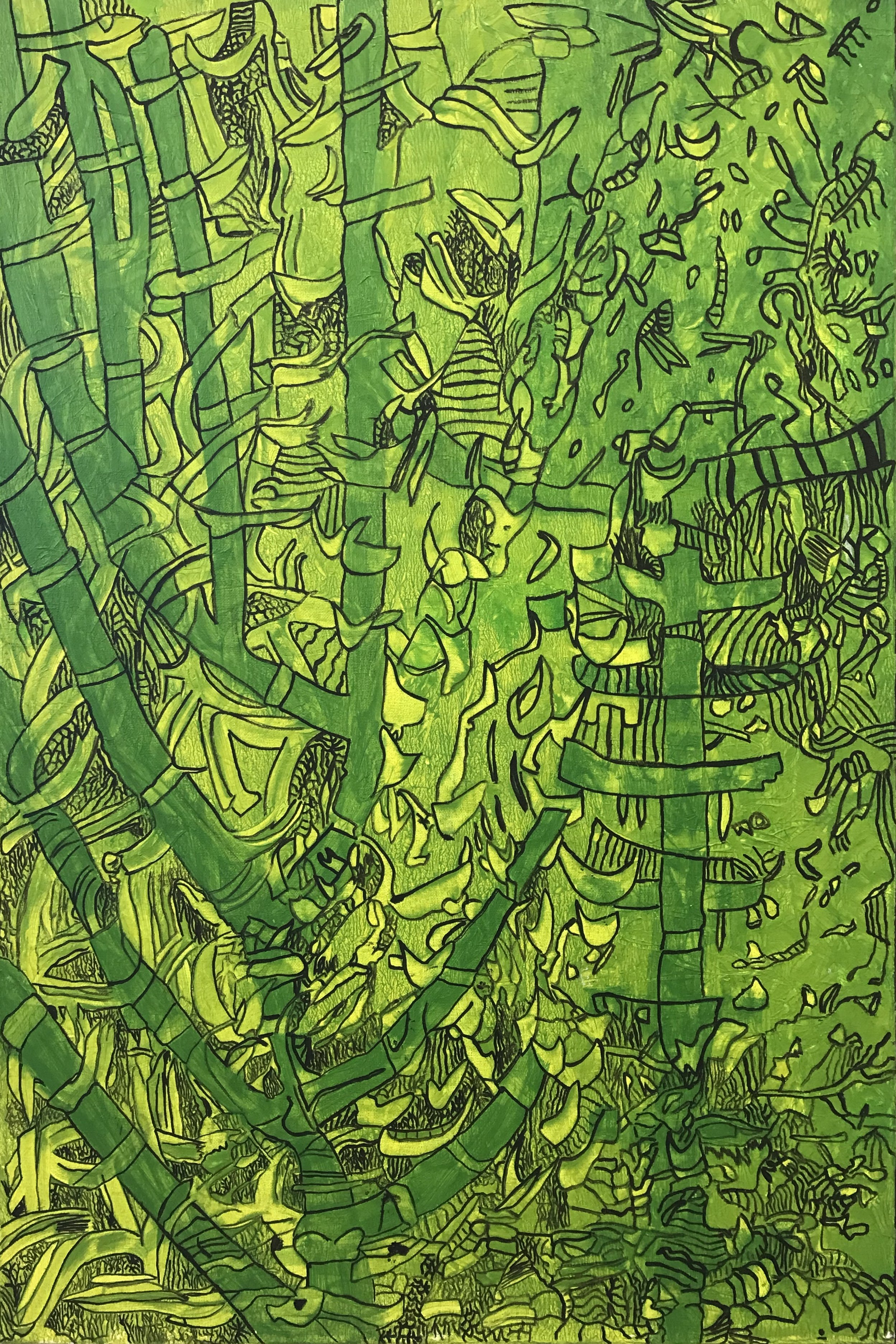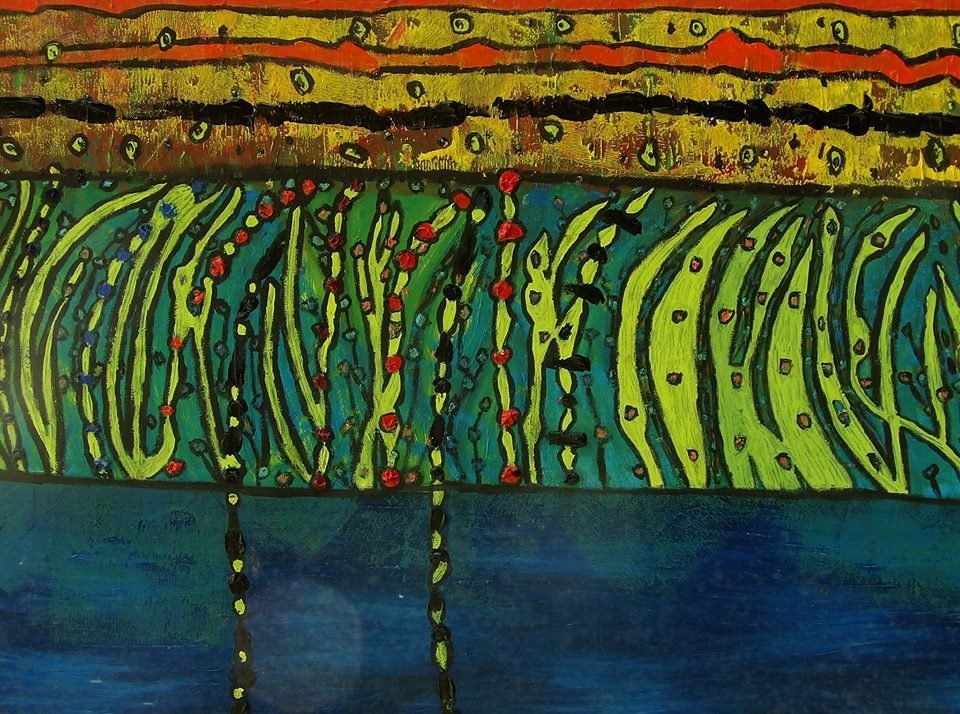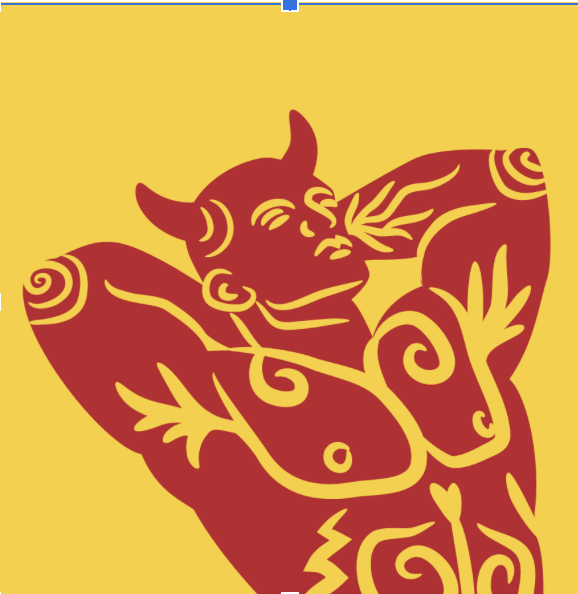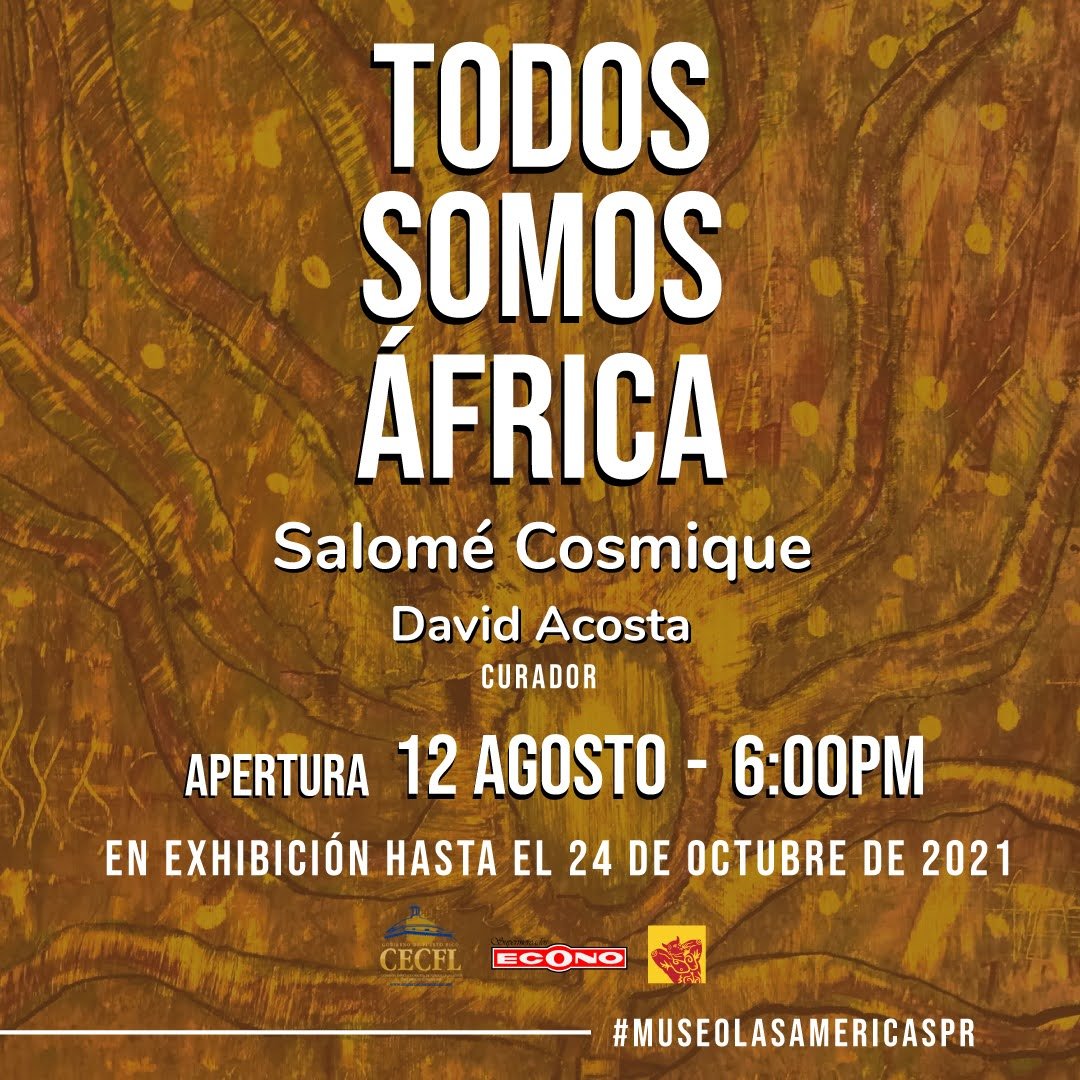Curatorial Statement
“Todos Somos Africa arises from four years of artistic exploration of the Taino and African cultures in Puerto Rico by Salome Cosmique. Composed of 15 paintings, this exhibition is the result of a series of interviews with a priest and practitioner of the African religion Palo Mayombe, as well as through the reading of the work of the renowned Cuban anthropologist Lydia Cabrera. We are all Africa seeks to remind us of our common human history, and that of our origins in Africa, from there come the mythical stories that excited and inspired the artist to create the paintings that are part of this exhibition.”
We are all Africa
Artist Statement
Towards a Pictorial Representation of the Orishas
The work in We are all Africa was created during my 4-year stay on the island where I studied a part of the history of Puerto Rico. The research conducted arose out of my interest in ritual, spirituality and in a series of interviews; I conducted with Tata Tony Oma Obatala who shared his ancestral knowledge with me. As I discovered the Orishas (thanks in great part to the reading of the book El Monte by the Cuban anthropologist Lydia Cabrera), Tata Tony was able to clarify my questions and doubts. We studied the myth (Patakis) and I listened to the songs of praise particular to each Orisha while painting each picture.
Each painting in this series is unique. The color of each one is inspired by the Elekes (necklaces), the myths (Patakis) and their songs. With this work, I seek to highlight the essence of these Orishas, which have been and continue to be a great source of cultural and spiritual inspiration in Puerto Rican and in Caribbean culture; in its music, its food, and the arts. In creating this work, I also sought to incorporate color elements inspired by African fabrics, as well as in the incorporation of the symbolic elements that define the personality and powers of each Orisha.
The work in “We are all Africa”, was exhibited as a solo show before leaving the island in 2017 at the Guatibirí Gallery in Río Piedras and now, I have the great opportunity to return to the island after four years of living in the USA to once again, exhibit this work inspired by your African ancestors.
Artist Bio
Salomé Cosmique is a Colombian artist, educator and curator currently residing in Philadelphia, Pennsylvania, (USA). She has a degree in visual arts from the University of Strasbourg in France. In 2012, (while in France) she obtained her National Diploma of Plastic Arts, with a concentration in sound arts from the School of Arts of the Rhine (Haut École D'art du Rhin) in Mulhouse, France. Upon finishing her studies, she moved to Puerto Rico, where she participated in several collective and individual exhibitions at the Tibes Ceremonial Center, the Museum of the Americas and at the Art Biennial of Ponce among others.
In 2017, Salomé moved to Philadelphia, Pennsylvania, (EE.UU) where she has continued to develop her artistic, curatorial and educational career. She is currently a curator of Dissident Bodies and works as an educator at The Barnes Foundation.
For Salomé, the arts form a positive vehicle which can bring beneficial changes to society as well as the potential to transform lives, art as a healer, something she promotes in her artistic pursuits. Since 2012, her performance work has been inspired by colonialism, immigration, women's inequality and dissident bodies. Through her pictorial work the artist seeks to remember the memories of our ancestors. She has exhibited in Europe, Latin-American, The Caribbean, the United States and India.
Curatorial Statement
David Acosta
When the Colombian artist Salomé Cosmique (María Afanador) approached me about curating the current exhibition “We are all Africa'' at the Museo de Las Americas in San Juan Puerto Rico originally scheduled for (May 14-June 14, 2020) but postponed due to the outbreak of Covid-19, I was excited. Salomé Cosmique’s work, when I first encountered it, appealed to me given the religious, cultural and political aspects that preoccupy her practice as both a painter and a performance artist. We share similar interests in history, mythology, folklore, religion, the study of esoteric religious practices, ecology, the environment and the histories of marginalized groups specifically within the context of dominant colonialist, patriarchal and heterosexist narratives.
Salome’s work explores counter narratives to dominant concepts of religion, myth, the environment and the female role in cosmology, myth, history and the present. Her work is oftentimes manifested in questioning spiritual and biological imperatives that continue to serve and in many ways define societal roles for women both, within patriarchal structures as well as those coming out of the feminist canon; themselves full of creative and oftentimes contradictory tensions within feminism itself.
We Are All Africa comes out of four years of the artist’s exploration of Taino and African cultures in Puerto Rico. Comprised of 15 paintings, “We Are all Africa” is the pictorial outcome of interviews conducted with an elder priest and practitioner of the African religion Palo Mayombe, as well as through readings of the work of the renown Cuban anthropologist Lydia Cabrera. A part of this cycle of the work created while on the island were also performances conducted over a four year period, in which the artist also explored through painting and performance work, Taino religious beliefs and mythology, as well as the colonial history of the island, the latter, an important focus for the artist given the ongoing historical and current political situation of Puerto Rico as a colony of the United States.
The work in “Todos Somos África” subsequently forms part of a sequence of paintings in which the artist continues to explore the representation of mythological deities. In more recent work, (created while living in Philadelphia), a focus on other deities such as Ganesha and Kali, this time from Hindu mythology, is manifested in new paintings. In more recent performative work, the Andean earth mother PachaMama, and the Ojibwe deity Asibikaashi* (Spider Grandmother) among others have entered the artist’s oeuvre allowing her to use the avatars associated with these deities to call attention to social issues important to the artist. More recently, femicide, the environment, and the human body are examined as a locus for the visitation of cultural affirmations, expectations, fears and anxieties manifested by our society at a time of accelerated change. We Are All Africa seeks to remind us of our common human story, our origins as a species in Africa, the land where the mythical stories that excited and inspired the artist to create the current work have their origin.
Art Work

Obatalá: 2016, (Mixed Media) King and father of all Orishas he is second only to Olodumare a divine entity with no mother or father. Olodumare is the origin of all things he is omnipotent and all knowing. Obatala is the creator of man and the earth which he undertook at the instruction of Olodumare and as such he is the representative of Olodumare on earth. Obatala’s color is white, and he is represented in Santeria by la Virgen de la Merced and Jesus Christ.

Ochosi: 2017, (Mixed Media) Ochosi is the Yoruba deity associated with the hunt, with forests and animals. As a deity associated with hunting he lives in the woods and is the provider of food. He is a skilled hunter, fishermen, and is also a sorcerer and a seer. He represents truth and what is just. He is also the enforcer of the rules that govern humanity. His color is blue and gold, and he is associated in Santeria with Saint Hubert.

Oggún: 2017, (Mixed Media) The god of war and metals and a metalsmith. He is a powerful Orisha considered the god of civilization because he created the tools that made civilization possible. He is the owner of all metals and as such is the patron of all professions that require the use of tools, such as architects, mechanics, surgeons, engineers, drivers among many others. He works closely with his brother Eleggua to clear obstacles from one’s path. In Santeria he is associated with St. Peter.

Oko: 2016, (Mixed Media) Orisha associated with the earth, with crops and with farming. He works closely with his brothers Ochosi and Oggún. In Santeria he is represented and associated with Saint Isidro. He is also associated with fertility, good fortune and health. He is also incredibly just, and he is considered a judge among the Orishas who call upon him to settle disputes.

Olodumare: 2017, (Mixed Media) Olodumare is the supreme being, he has no beginning nor end as he was not born of a father and a mother. He has always existed, and he is the creator of heaven and earth, he is night and day, and he is the ultimate juror of mankind. He is an aloof being who does not involve himself with the daily routines of human beings which he leaves to the Orishas. His name means owner of the universe. While the Orishas are seen as punishers it is Olodumare who stands upon final judgement over the souls of the dead. He is father of all and is represented by the sun. One way to think about him is that he is similar to the supreme being of other religions.

Orula: 2016, (Mixed Media) Is the Orisha representing wisdom and is seen as a god of prophecy and destiny. He is one of the most important of the Orishas. He is the god who presides over the oracle of Ifa and over the ceremony of Ita. Towards the end of the initiation ceremonies the initiates must go and consult with Orula, this is the ritual known as “ita”. The outcome of this divination ceremony determines many aspects of the initiates life from that moment forward including prohibitions against certain habits, such as dress, and how one should comport oneself, even what types of foods one is allowed to eat, and which must be avoided. The result of the consultation becomes a guide for the future behavior of the Santero/a.

Ochún: 2016, (Mixed Media) The most beautiful of the Orishas she is the goddess of love, beauty the feminine, she is also a goddess associated with fertility, with beauty and with wealth. She is the goddess of rivers and waterfalls and besides Obatala is the only one who has direct access to Olodumare as she asks him for favors to help humanity. This is in part because she is a primordial spirit and was sent by Olodumare to help create the world. She is revered for being kind, loving and generous. She is represented in Santeria with Our Lady of Charity.

Ossain: 2016, (Mix Media) The importance of Ossain as the god of nature, plants, animals, rocks, and all living things cannot be underestimated as he rules over all things used in the sacred rituals of Santeria. Without him there is no ritual. He is a healer a seer and his birth brought all that is good and beautiful into the world.

Oyá: 2016, (Mixed Media) Oya is the only female warrior among the Orishas. She controls storms and the wind. She is also a witch and the patroness of death. In Cuba she is said to guard the door to the cemeteries. She is the only Orisha able to use her husband Chango’s thunderbolt. The name “Oya” means to “tear apart” which is a direct reference to her powers of commanding the wind in powerful storms. She is represented in Santeria with la Virgen de la Candelaria.

Shangó: 2016, (Mix Media) Perhaps one of the most popular of all the Orishas. A powerful, tall, handsome and fierce warrior he is just and loyal. He is the god of fire, thunder and the thunderbolt. He loves music and dance and is considered a great lover having had intense relationships with many of the female Orishas three of which became his wives: Oya, Oshun, and Obba. The drums which are central to the worship of the Orishas are sacred to him as are the dances. He represents the joy of living life, male beauty, knowledge and wealth. He was originally the first owner and interpreter of the oracle of ”Ifa” which he gave to Orula and is the interpreter of the Diloggún, the form of divination in the Yoruba religion. His colors are white and red, and he is represented in Santeria by Santa Barbara.

Yemayá Iyá: 2016, (Mixed Media) Yemaya is the universal mother, goddess of the oceans and all bodies of waters lakes, rivers, waterfalls. She is the mother of all things that live in the ocean and fish are her messengers. She is the protectress of women and children and presides over all aspects of childbirth and fertility including the amniotic fluid where the baby lives for the first 9 months before birth. Legend has it that after her water broke she gave birth to all of the waters and animals of the ocean including the first humans. In Santeria she is associated with Nuestra Señora de la Regla.

Todos Somos Africa, 2016, (Mixed Media)

Africa, (2016), (Mixed Media)

Africa, 2016, (Mixed Media)

Elegua: 2016, (Mixed Media) Perhaps the most important and complex of all the gods of the Yoruba pantheon. He is the guardian of roads. All Santeria rituals begin with Elegguá as he must give permission for the rituals to begin and to continue. He holds the keys to the past, the present and the future and is the first orisha called during the “toque” and he is also the first to be served food before all of the other Orishas. He is mischievous and unpredictable. His colors are red and black. He is associated in Santeria with the Infant of Prague.
Press:


